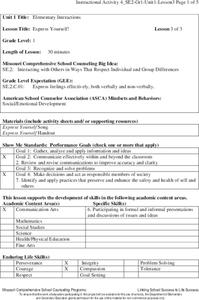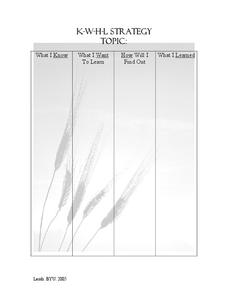Missouri Department of Elementary
Happy, Sad, Scared and Mad: All Belong To Me
"What are feelings?" and "Why are feelings important to understand?" are the essential questions of a lesson that boosts self-awareness. Scholars discuss the four basic emotions—happy, sad, scared, and mad—in preparation for a creative...
Santa Clara County Office of Education
The Rainbow Fish: Activities for Parents to Do with Children at Home
The Rainbow Fish, Marcus Pfister's award-winning story about the joys of sharing, is the inspiration for this resource loaded with fun. Suggestions for language and language arts, math, science, and social studies activities are included...
Guam Community College
Joseph Had a Little Overcoat
Spruce up a class reading of the children's book Joseph Had a Little Overcoat by Simms Taback with this fun series of activities. Starting with a list of reading comprehension questions and key vocabulary to address during a teacher read...
Shakespeare Globe Trust
The Taming of the Shrew
What does it take to build a stage production from the ground up? Scholars read a weekly blog detailing the behind-the-scenes action of William Shakespeare's The Taming of the Shrew. They also listen to interviews with the cast, meet the...
ESL Kid Stuff
Subject Pronouns (I, You, He, She, We, They)
How are you feeling? Language learners practice using subject pronouns with adjectives by responding to questions, engaging in games, and singing songs.
Curated OER
Picture Fists Full of Kisses
Ease children's back-to-school jitters with this primary grade lesson based on the book The Kissing Hand by Ruth E. Harper. Starting off with a singing of the song "I Wish I Had a Little Red Box", children go on to discuss and create a...
Crafting Freedom
Harriet Jabocs and Elizabeth Keckly: The Material and Emotional Realities of Childhood in Slavery
Learning how to make accurate inferences by putting together facts found in multiple sources is one of those skills all learners must develop, but one that can be a challenge to teach. This resource is a must-have for your curriculum...
Crafting Freedom
Harriet Jabocs and Elizabeth Keckly: The Material and Emotional Realities of Childhood in Slavery
Through the journals written by Harriet Jacobs and Elizabeth Keckly, young readers gain insight into the lives of two enslaved children on nineteenth-century plantations.
English Enhanced Scope and Sequence
Identifying Synonyms
"Let the hunt begin!" As an introduction to synonyms, second graders generate a list of word pairs that have similar meanings. The words pairs are written on sentence strips, cut apart, shuffled, and distributed to class members who must...
Curated OER
Book Nook
A reading of Dr. Seuss's My Many Colored Days provides a great intro for a discussion of colors and how they can represent emotions and moods. Kids share the feelings they associate with various colors
Missouri Department of Elementary
Express Yourself!
Encourage scholars to express themselves with help from an engaging song. Sung to the tune of "London Bridge is Falling Down," participants sing phrases that offer tips for dealing with emotions—sad, happy, worried, proud, mad, and...
Missouri Department of Elementary
What Are Safe and Unsafe Drugs/Medicines/Objects?
Encourage responsible decision-making while boosting sorting skills with a instructional activity that looks at safe and unsafe situations. Scholars use two bags, one happy the other sad, to sort scenario cards. After a thorough...
Missouri Department of Elementary
My Feelings
Encourage self-awareness with a lesson that challenges scholars to identify feelings—happy, sad, mad, and scared. Using a feelings thermometer, similar to that of a bar graph, pupils discuss how they would feel in specific scenarios then...
K12 Reader
Color Shows Mood
Colors, primary colors, secondary colors, neutral colors, mixing colors, the color wheel. As a reading comprehension exercise, kids read a short passage about colors and then answer a series of questions based on the article.
Curated OER
Diary Writing
As part of their reading of Michael Morpurgo's novel Kensuke's Kingdom, young castaways create diary entries describing their own time left alone on an island.
K12 Reader
Identify the Antonym
What happens to a sentence when you replace a word with its antonym? A two-part instructional activity asks learners to select words opposite in meaning to provided words, and then to craft sentences using antonyms for given words.
K12 Reader
Opposite Words: Adjectives
Here's a colorful activity that asks kids to write a word, opposite in meaning, to the word pictured. The template includes picture clues.
The New York Times
650 Prompts for Narrative and Personal Writing
An extensive list of narrative prompts is just what you need to inspire young writers to tell their stories. Arranged by topic, the questions are sure give them something to talk about.
Savvas Learning
Adjectives
Provide language learners with lots of opportunities to practice identifying and useing adjectives. The games and activities in this 19-page grammar packet are designed just for them.
K12 Reader
Making Connections to Text
This short reading comprehension worksheet encourages readers to make self-to text, text-to-text, and text-to-world connections as a way of remembering what they have read.
K12 Reader
Using Antonyms for Context Clues
Readers use the antonyms provided within a sentence to help them determine the meaning of underlined words in the sentence. The learning exercise is the final resource in a series that provides opportunities to kids to demonstrate their...
Novelinks
Tuesdays with Morrie: K-W-H-L Strategy
Readers of Tuesdays with Morrie are directed to use a K-W-H-L chart to record what they know, what they want to learn, how they will find information, and what they learned about a particular topic related to Mitch Albom's book.
Curated OER
Section 1: Analogies
Introduce your freshmen to analogies with this packet of prompts that also includes strategies for solving these critical thinking puzzles.
Teacher Web
Poetic Sound Devices
As part of a study of poetic devices, kids are asked to identify the assonance, consonance, and alliteration found in a series of lines of poetry, and then identify the rhyme scheme and the types of rhyme found in Poe's "Annabel Lee,"...

























